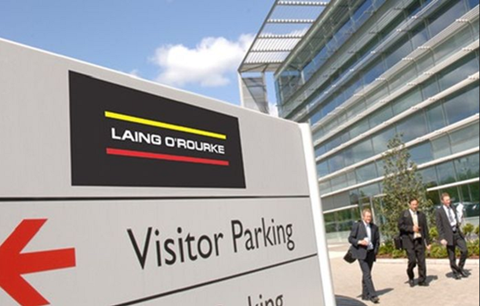A personal disaster for the UK’s biggest private contractor is also a window into where contracting seems to be right now, writes Dave Rogers
It is difficult to know where to begin with Laing O’Rourke’s latest results.
Where to start indeed? Perhaps with whether it is a legitimate question to ask the finance director of Laing O’Rourke – that’s Laing O’Rourke, the country’s biggest private contractor by some distance!! – if the firm is going to go bust.

Unfazed, because one suspects she has been asked this several times in the past few weeks, especially by clients, Rowan Baker took the question on, answered it in a roundabout way before finishing her sentence with one word: “No.”
It is worth repeating the basic black and white facts about Laing O’Rourke’s latest accounts: a company that turned over £3.6bn last year has managed to post a pre-tax loss of £288m.
Whatever has gone wrong, it does no one in construction any good for this to happen. So, then, what, again, do these numbers say about the industry, about the way it operates, its attractiveness, the way it does business? Is it even possible for firms to do anything more than simply scrape by?
Do young people really want to work in an industry where contract disputes, slanging matches, ranting and raving, minimal margins, huge losses, boom and bust are part and parcel of a business culture?
If someone called Ray O’Rourke or Robert McAlpine or John Mowlem were a 20-something today, would they really go: “Yup, contracting seems like a good bet to me. Plenty of money to be made there. Easy-peasy, I’ll give it a go?”
Ah-ha, say the sceptics, look at the major contractors running around in their big cars, with their seven-figure salaries, their houses in the country – they’ve not done too badly. Do some of the best-known architects, cost consultants, developers, clients, funders not do the same?
At times, writing about contracting this year has felt like writing the obituary for an industry. The most sobering thing about Laing O’Rourke’s loss is that it is nothing new. Is anyone really surprised a contractor – forget that it is Laing O’Rourke for the time being – has shipped close to £300m?

Of course, there are questions about Laing O’Rourke’s business decisions. Baker said the firm would not have signed a deal in Australia today which has cost it £144m in provisions and £32m in legal fees. And questions about whether firms should do fixed-price. Funders will only seemingly ever lend if they can cap the amount they will hand over.
Something is broken in construction, but no one really knows how to fix it, so the industry plods on
Then there are questions about whether some firms are the architects of their own misfortune. Laing O’Rourke does seem to like a trophy job, as well. Beware hubris and all that.
But not every contractor that sinks to losses like O’Rourke’s is indulgent, incompetent, a basket case, incapable of making one sensible decision followed by another. For sure O’Rourke will have made some bad decisions somewhere along the line – a loss of £288m is proof of that – and no doubt there has been a lot of soul-searching at its Dartford head office.
Yet, there is a recurring theme here and it is not that every single contractor caught short by one bad job – or two, or even three – is a complete idiot. This has happened time and time and time again. Something is broken in construction, but no one really knows how to fix it, so the industry plods on.
There is a phrase beloved by historians, a version of which runs thus: those that cannot remember the past are condemned to repeat it.
Too often, we have been here before. Indeed, the irony is that Laing O’Rourke came into being because a distressed seller, John Laing, pulled the plug on contracting because a series of problem jobs became too much to cope with and it was easier to make money elsewhere.
So the construction arm – the one most people not in the industry had heard of – was sold for £1 to O’Rourke, then a concrete business, when at the start of the sale process John Laing had been privately briefing that it would fetch £100m.
>> See also: ‘The industry is broken.’ The soul-searching begins as London M&E specialist succumbs to familiar foes

O’Rourke’s £288m of red ink is not the first kind of eye-watering loss a firm has posted in recent times and yet it is difficult to argue that it won’t be the last. In short, it is not unprecedented.
When Balfour Beatty racked up a £304m pre-tax loss in 2015, the firm’s then new chief executive did not mince his words. The figures were “horrible” and “awful”, Leo Quinn said.
When Balfour posted those losses, they were, an independent audit found, the result of 89 problem contracts. Laing O’Rourke won’t say what its problem jobs are but it seems to be down to three schemes. Not 89. Three.
There is the overseas one, in Australia, signed in 2010, which O’Rourke was terminated from seven years later. Back in the UK, the two projects under the microscope are believed to be its jobs at Olympia and Whiteleys, both mixed-use jobs in west London and both fixed-price.
The Olympia scheme, believed to be £600m, was signed with client Yoo Capital in May 2021 but, a few months later, dozens of design changes were submitted to the local council. They are on the local authority’s website, hiding in plain sight.
The scale of these is in dispute but, in his chairman’s statement, Sir John Parker, a plc veteran and a respected businessman who was once the chair of Anglo American for eight years, referenced “factors impacting Laing O’Rourke’s UK profitability” as including “new clients, with high-value projects, requesting major design changes post-contract”.
O’Rourke, one of just a handful of firms who can actually do the work at Olympia or Whiteleys and with its own in-house supply chain, seems to be waving goodbye to mixed-use commercial work. Who wins?
He adds: “As a result, Laing O’Rourke will adjust its future exposure to certain clients and sectors in the UK.”
In other words, O’Rourke, one of just a handful of firms who can actually do the work at Olympia or Whiteleys and with its own in-house supply chain, seems to be waving goodbye to mixed-use commercial work. Who wins? Not the clients in mixed-use, that is for sure, as the limited pool of suppliers prepared to take a look at their jobs shrinks by one.
Chief executive Ray O’Rourke used his statement in the accounts to point out that the “surge” in construction costs over the year had been unprecedented. So, have clients and their advisors shown much sympathy?
He doesn’t seem to think they have. “In the UK, our profitability was hit by the effects of inflation on certain fixed-price contracts. During my long career, I cannot recall such a sharp surge in costs.
“We have sought to collaborate with clients to manage the impacts of this and keep projects on track, but our commitment to finding solutions in a difficult environment has not always been reciprocated.
“Inequitable risk-sharing adds to the ongoing turbulence across construction. It directly impacts our business and all of our people and it convinces me that the need for radical transformation is more pressing than ever.”
There is a story that Buckingham, which – remember – at the start of the year was talking about a turnover of £700m before it collapsed eight months later, was in part felled by a contract in which the client refused to budge on the price they had signed it for. Whatever they said, this client would not move. You signed it, your problem, you deal with it. Who wins? Madness.
A few weeks ago, the interim chair of HS2, Sir Jon Thompson, faced a meeting of MPs on the public accounts committee.

One of the things he said was this: “The government decision to let a cost-plus contract [on HS2] where there are very few incentives or penalties around them, does not provide me with any real levers on those contractors to do better in relation to schedule and costs, because they receive a marginal reduction in their fee.
“If they spend 100% more than what was originally agreed, they only get a 1% reduction in their fee.”
He may have been pointing out facts, but it did also seem like he was painting contractors as a bunch of firms getting a free ride. What was the alternative? Fixed-price? Lump sum? An entire industry might have been bankrupted by its own government if that had been the case.
One chief executive, who asked not to be named, was incandescent at what Thompson said. “We are not going to take a lump sum when the design is incomplete, the design keeps changing, we don’t know what’s in the ground, we don’t know the specification and we don’t know about the utility diversions.
“If he had said, ‘we have an opportunity to improve cost control’, then fine, I’d give him a pat on the back. But he didn’t – and most poor clients tend to pick on the supply chain first.”
Here, it is worth bringing up again a recent note by broker Liberum which explained the industry’s reluctance to take on HS2 risk because of what a job of this scale could do to firms’ finances if things went wrong.
Firms should go bust because they are incompetent, badly run and are doing a terrible job
“The problem is that inflation, which is particularly marked in building materials, is increasing the cost of the contract,” it said. “Delays in an inflationary environment only increase the cost further.
“Given that the contract is essentially cost-plus, that increase in cost means an increase in price, which is borne almost entirely by the taxpayer. The construction industry would never have taken this open-ended risk since it simply could not have afforded the downside.” Yesterday, it was announced that G&T would be conducting a review of why costs are so out of kilter with the original estimate. Here’s a thought: it’s not all to do with grasping contractors.
As this publication has said before, firms should go bust because they are incompetent, badly run and are doing a terrible job. Not every firm that posts losses is a victim of bad client behaviour or, in some cases, a bunch of costs consultants trying to make a name for themselves. But, sometimes, it really does feel that the cards are stacked against them and firms are brought to the brink too many times.
“Construction is an industry of strategic economic importance and the products we deliver for our clients underpin the quality of life we all enjoy,” Ray O’Rourke writes. “Governments have a vested interest in ensuring their domestic constructors are productive and successful and, certainly in the UK, much more needs to be done to make this happen.
“For its part, the industry needs to increase productivity, create better work, and improve the wellbeing of its people. Governments, meanwhile, need to provide clarity as to the infrastructure pipeline they want delivered.
“Procurement is labyrinthine and pedestrian and there is too little collaboration on design to drive delivery efficiencies and value for money. The automotive sector, aviation and major shipbuilding have all addressed their commercial models and it is time for construction to do the same.”
Remember Sir John Egan, the man behind Rethinking Construction? Older heads will recall that he said pretty much the same thing, too. That was 25 years ago when Laing was still John Laing and O’Rourke was still a concrete subcontractor.
Dave Rogers is deputy editor of Building



























1 Readers' comment